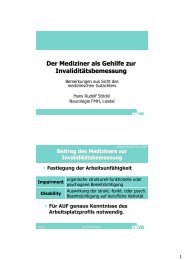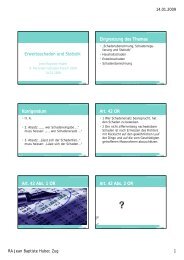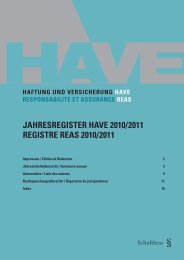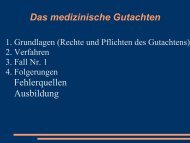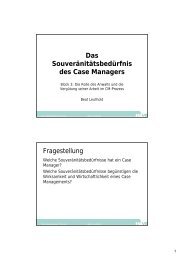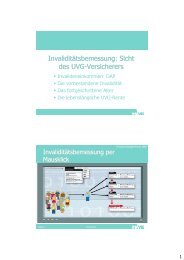Swiss Solvency Test - Have
Swiss Solvency Test - Have
Swiss Solvency Test - Have
You also want an ePaper? Increase the reach of your titles
YUMPU automatically turns print PDFs into web optimized ePapers that Google loves.
<strong>Swiss</strong> <strong>Solvency</strong> <strong>Test</strong>Philipp Keller, Federal Office of Private InsuranceLuzern, 22. November 20051
Contents• Risk Based Supervision• Concept of the <strong>Swiss</strong> <strong>Solvency</strong> <strong>Test</strong>• Experiences from the Field <strong>Test</strong>s• Internal Models2
Timeline of the SST Development20032004Herbert Lüthy becomes new director of FOPI (Federal Office of Private Insurance)in Fall 2002, reorientation to prudential supervisionStart of <strong>Swiss</strong> <strong>Solvency</strong> <strong>Test</strong> project Mai 2003 with participation of industry,actuarial and insurance association, consulting companies and othersConceptual work finished end of 2003Up to Mai 2004, development of first version of the standard model2005Field test 2004 with 10 insurers,supported by consulting companiesAdaptations and improvements on the standardmodel and the methodology of the SSTField test 2005 with 45 insurers coveringapprox 90% of the marketSetting up of <strong>Swiss</strong>Standard Board as aconsultative bodycomposed of industryrepresentatives andregulators2006Further development underway on requirementson internal models and group effectsInsurance supervision act to beimplemented on 1.1. 20063
Purpose of Insurance RegulationPolicy holder protection by ensuring that• promises to policy holders will be fulfilled with a high probability• consumer protection• a choice of products are available by promoting a thriving andinnovative insurance marketFoster trust in insurance market by ensuring that•promises are kept• stakeholder get a realistic picture of the companiesHaving a level playing field by• treating companies equally in the sense that all – small or large -have to fulfill regulatory requirements• requiring similar capital requirements from companies having similarrisks4
Risk ManagementWir müssen wissen. Wir werden wissenDavid HilbertRisk management is responsible for identifying, assessing, analyzing,quantifying and then transferring, mitigating or accepting of riskRisk management has to be embedded within the culture of thecompanyFor risk management to be effective, there needs to be a risk culturesuch that senior management wants to know and risk management isable to tell the “truth” about the risksSenior management and the board have to ensure that there is a honestdialog and transparency regarding risks within the companyRisk management is not solely about control but aboutconfronting issues and uncomfortable truths openly and honestly5
Implications of Principles vs RulesPrinciple-based standards describe the objective sought ingeneral terms and require interpretation according to thecircumstance.PrinciplebasedObjectiveRulebasedObjective=Risk BasedCapitalRequirementPrinciples will have to be interpreted accordingto their intention, not legalistically by seniormanagement and by the supervisorAny rule based framework, by taking awayresponsibility from companies, tends to bearbitraged again and an “arms race” betweenthe rule-makers and the arbitrageurs will lead toa proliferation of rules to fill loop-holes.If principles will beinterpreted legalisticallyby companies, regulationwill deteriorate rapidly toa rule-based, compliancedriven framework withhigh compliance and legalcosts for all6
Contents• Risk Based Supervision• Concept of the <strong>Swiss</strong> <strong>Solvency</strong> <strong>Test</strong>– Requirements– Principles– General Framework– Market Value Margin• Experiences from the Field <strong>Test</strong>s• Internal Models7
Requirements of the SSTAs simple as possible, ascomplex as necessaryIncentivizes riskmanagementRequirements follow fromregulatory intentionsMinimizing unintendedconsequencesInternationalCompatibilityEconomic ViewCapturing all relevantrisks and risk mitigationsCapturing group effectsReliance on internal models for complex companies(e.g. groups, reinsurers,…), use of a standard modelfor small to mid-sized companies that is risk sensitiveand rewards risk managementClearly stated principles, responsibility of adherence toprinciples on senior management, avoid rules andlimits which can be arbitraged againstAvoid/minimize effects of legacy regulation (e.g. limitson investment, inconsistent valuation rules, …)Market value margin type risk margin, SCR as pureone-year risk, no implicit prudence marginsMarket consistent valuation of assets and liabilities,total balance sheet approachAllows for reinsurance, ALM, hedging to be taken intoaccount via a risk-specific standard model and by aninternal modelAllows for group diversification given fungibilityrestrictions, taking into account all relevant intragrouprisk and capital transfer instruments8
Development ProcessIdeally, insurers and regulators shoulddevelop solvency framework togetherInvolve all stakeholders as far aspossible: accountants, actuaries, CEOs,CROs, investors, risk managers,…A prerequisite of this approach is thewillingness of all to:•enter into a dialogue and learn fromeach other;•fight out controversial points openly andbeing able to compromise;•accept differing points of views (e.g.shareholder view vs. policy holderprotection).FOPI opened several channels<strong>Swiss</strong> Standard Board: A panelconsisting of industryrepresentatives, consultantsand regulators to discuss openproblemsSeveral working groupscomposed of industryrepresentatives and regulatorsto formulate guidelines for SSTIncreased involvement of FOPIin work by <strong>Swiss</strong> ActuarialAssociationPublic presentations, seminars,workshops,…9
The SST Concept: Principle-BasedThe more laws and order are made prominent, themore thieves and robbers there will be, Lao-tzuCore of the <strong>Solvency</strong> <strong>Test</strong>PrinciplesDefinitionsGuidelinesStandard ModelThe SST is defined not by the Standard Model but byunderlying principles• Principles define concisely the objectives• Definition of terms and concepts so thatmeaning and possible interpretation ofprinciples become clear• Guidelines help in interpretation• Standard Model allows use of<strong>Solvency</strong> <strong>Test</strong> also by smallcompanies10
The SST Concept: Principle-BasedDefinesOutputDefinesHow-toTransparencyResponsibility1.All assets and liabilities are valued market consistently2.Risks considered are market, credit and insurance risks3.Risk-bearing capital is defined as the difference of the market consistent value ofassets less the market consistent value of liabilities, plus the market value margin4.Target capital is defined as the sum of the Expected Shortfall of change of riskbearingcapital within one year at the 99% confidence level plus the market valuemargin5.Under the SST, an insurer’s capital adequacy is defined if its target capital is lessthan its risk bearing capital6.The scope of SST is legal entity and group / conglomerate level domiciled inSwitzerland7.Scenarios defined by the regulator as well as company specific scenarios have to beevaluated and, if relevant, aggregated within the target capital calculation8.All relevant probabilistic states have to be modeled probabilistically9.Partial and full internal models can and should be used10.The internal model has to be integrated into the core processes within the company11.SST Report to supervisor such that a knowledgeable 3rd party can understand theresults12.Disclosure of methodology of internal model such that a knowledgeable 3rd partycan get a reasonably good impression on methodology and design decisions13.Senior Management is responsible for adherence to principles11
The SST Concept: General FrameworkStandard Models for insurance risk:Nonlife: Split into small and large claims andcatastrophesLife: biometric and policy holder behavior riskmodeled using multivariate normal approachCredit risk calculatedusing Basel II or portfoliomodel (e.g. credit metrics)ModelsMix of predefined and company specificscenariosScenarios add approx. 15% (median) tocapital requirement.Credit risk of reinsurers’ default modeledusing a scenario (adding btw.) 0.01%and 7% to capital requirementScenariosAsset-Liability Model usingcovariance approachFinancialRisksInsuranceRisksCreditRisksAggregation by weightedaverage of differentdistribution functions(weight = probability ofscenarios occurringAggregation MethodTarget CapitalSST Report12
The SST Concept: Market Value MarginDefinition: The market value margin is the smallest amount of capital which isnecessary in addition to the best-estimate of the liabilities, so that a buyer wouldbe willing to take over the portfolio of assets and liabilities.Market Value Margin = cost of the present value of future regulatoryrisk capital associated with the portfolio of assets and liabilities∑MVM=CoC ⋅ ES⎡⎣ΔRBC(t) ⎤⎦t≥2ES with portfolio converging from actual to replicatingportfolio taking into account illiquidity of assetsES with optimallyreplicating asset portfolioAchievable Replicating Portfolio hasconverged to Replicating Portfoliot=0t=1 t=2 t=3YearsFuture regulatory risk capital enteringcalculation of the market value margin at t=013
Contents• Why Risk Based Supervision• Development of the Framework• The Major Principles• First Results– Impressions from the Industry– Principle-based Approach– Some Quantitative Results• Future Challenges14
Impressions from the IndustrySome have a somewhat reluctant attitude:SST will favour large companies that have already sophisticatedrisk-based management systems in place …’‘Small companies without internal model will be punished by theStandard Approach of SST…’‘SST may call for a complete overhaul of risk management …’‘Technical implementation can become a problem …’‘… transparency and fair values will further increase the volatilityof earnings …’‘… complexity of internal models will allow companies to game thesystem …’‘SST leads to complexity where simplicity is required …’‘SST will increase the minimum <strong>Solvency</strong> level …’We would like to thank Andreas Kull (Ernst&Young) for the permission to use this slide15
Impressions from the IndustrySome see it in a positive light:‘…facilitates more efficient use of risk capital …‘‘Facilitates company wide risk culture and dialogue…’‘… will reward companies that have a comprehensive riskmanagement in place…’‘… internal models are an excellent management tool and can bea competitive advantage…’‚Rating dependent premiums will gain acceptance.‘‘Increased transparency in the insurance sector may reduce costof capital for the sector as a whole…’‘… will lead to increased transparency in an insurer's financialstrength/weakness…’‘… is an effective regulatory instrument to prevent insolvencies…’We would like to thank Andreas Kull (Ernst&Young) for the permission to use this slide16
Results of the Field <strong>Test</strong>s: Principles vs RulesPrinciples work:Example: The requirement for the SST report was to send tothe supervisor a report detailing the assumptions, calculations,simplifications etc. such that a knowledgeable 3rd person canunderstand the resultResult: The overwhelming majority of reports were ofexcellent qualityRequiring adherence to principles often leads to better quality and bettercompany specific results than fixed rules which tend to foster a climatewhere execution mainly deals with pure compliance17
Results of the Field <strong>Test</strong>s: Volatility of SSTIs economic solvency more volatile than <strong>Solvency</strong> 1?Sample: <strong>Solvency</strong> 1 ratios of approx. 100 life and nonlife companies over thelast 5 years• The average standard deviation of thechange of the <strong>Solvency</strong> 1 ratio overthe 5 year mean is approx 30%• 1/3 of the companies had at least oneyearly change of <strong>Solvency</strong> 1 ration inexcess of 50% during the last 4 years• 10% of the companies had at leasttwo years, where the <strong>Solvency</strong> 1 ratiochanged by more than 50% duringthe last 4 years• For approx half of the companies isthe minimal <strong>Solvency</strong> 1 ratio duringthe last 5 year less than half of themaximal <strong>Solvency</strong> 1 ratio.Histogram of the standard deviationof the change of solvency 1 ratiosaround the 5 year mean18161412108642• For 10% of the companies is the minimalsolvency 1 ratio during the last 5 year less than25% of the maximal solvency 1 ratio.Results do not deviatesignificantly between lifeand nonlife companies00 0.2 0.4 0.6 0.8 1 1.2 1.4 1.6 1.818
Results of the Field <strong>Test</strong>s: ScenariosEffect of Scenarios Expressed as Fraction of RBCEffect of Scenarios in Relation to Risk Bearing CapitalScenarios evaluated bycompanies1: Longevity2: Morbidity3: Daily Allowance4: Bus Accident5: Stadion Cat6: Hail7: Barrage Cat8: Industrial Acc9: Pandemic10:Financial Distress11:Reinsurance12:Terrorism13-14:Own ScenariosLoss under Scenario / Risk Bearing Capital10.80.60.40.201 2 3 4 5 6 7 8 9 10 11 12 13 14Scenario19
Market Value MarginMarket Value Margin / Best Estimate vs Market Value Margin /ES[RBC], based on provisional data of Field <strong>Test</strong> 2005X-axis: MVMdivided by bestestimate ofliabilitiesY-axis: MVMdivided by 1-yearrisk capital (SCR)0.70.60.50.40.3MVM / Best Estimate vs MVM / 1-Year Risk CapitalNonlifeLifeLife companies writingpredominately risk products0.2Life companies0.1writingpredominatelysavings products00 0.01 0.02 0.03 0.04 0.05 0.06 0.07 0.08Market Value Margin / Best Estimate20
Contents• Why Risk Based Supervision• Development of the Framework• The Major Principles• First Results• Future Challenges– Group Effects– Internal Models– Transparency21
Scope of Regulatory Models: GroupSubsidiaries: Can be in all parts of the world, home country regulator can not calibrate easily (if atall) a standard model to different risk profiles. Mix of legal entity risk to risks emanating fromsubsidiaries is widely varying from group to group. Capital flow between subsidiaries and parent isrestricted.Risk specific standard model for group is extremely difficult to developsince in addition to legal entity model restrictions on fungibility ofGroupcapital need to be taken into accountSubsidiaryBranchSubsidiaryParent CompanySubsidiaryParent Company: Standard model canbe calibrated using local, countryspecific statistics and modelsLegal EntityBranchBranchRisk specificstandard model isfeasibleBranches: Can be in all parts of the world, home countryregulator can not calibrate easily (if at all) a standardmodel to different risk profile. Mix of parent country risk torisks emanating from branches is widely varying fromcompany to companyBranchRisk specific standardmodel for legal entityis very difficult todevelopCapital can flow (nearly) freely betweenbranches and parent company and legalentity can be considered to be one riskentity.Diversification between parent andbranches.22
Group EffectsGroup effects have to be captured consistently: for group capital requirementsand for subsidiaries which are part of a group-> take into account all formal, legally binding capital and risk transferinstrumentsIntra-group retrocession, contingentcapital issued and received, etc.Fungible capitalGroupLegal Entity 1Market Value MarginParent CompanyLegal Entity 2Legal Entity 3A group can set upweb of risk andcapital transferinstruments suchthat regulatorycapitalrequirements forthe group and forits legal entities isoptimizedIntra-Group Capital and RiskTransfer Instruments:• Intra-groupRetrocession• Guarantees• Participations• Dividends• Loans• Issuance ofsurplus notes• securitization offuture cash flows /earnings• sale / liquidation ofa business23
Internal Models: Regulatory ChallengesWhen allowing internal models for target capital calculation, theproblems a regulator faces are:• How to ensure that the results are comparable betweendifferent companies• How to ensure, that a company is not punished if it modelsrisks more conscientiously than its peers• How to be able to distinguish between acceptable and notacceptable models• Finding the criteria that show that a model is deeplyembedded within a company24
Internal ModelsEven worse than having a bad model is having any kind ofmodel – good or bad – and not understanding itIf internal models are used forregulatory purposes, it will beunacceptable if the model is notunderstood within the companyThere needs to be• deep and detailed knowledge by thepersons tasked with the upkeep andimprovement of the model• Knowledge on the underlyingassumptions, methodology andlimitations by the CRO, appointedactuary etc.• Sufficient knowledge to be able tointerpret the results and awarenessof the limitations by seniormanagement and the boardSenior management is responsible forinternal models and the review process.The review of internal modes will bebased on 4 pillars• Internal Review;• External Review;• Review by the Supervisor;• Public Transparency.The regulator is responsible forascertaining that the review process isappropriateCompanies using internal models haveto disclose publicly the methodology,valuation framework, embedding in therisk management processes etc.25
Internal Models: Public TransparencyThe public disclosure requirements on internal models should beprinciples based. The amount of information to be disclosed shouldbe based on the principle that a knowledgeable person can get areasonably good impression on the basic methodology of theinternal models as well as on the major design decisions. Inparticular a description of the following main features should beprovided:• valuation methods (for assets and liabilities);•risk measure;• criteria for the choice of parameters and distribution functions;• major scenarios and risk factors and the assumptions on theirdependencies;• aggregation methods;• embedding into the company's risk management processes;• scope of the model and which relevant risks are not quantified.26



